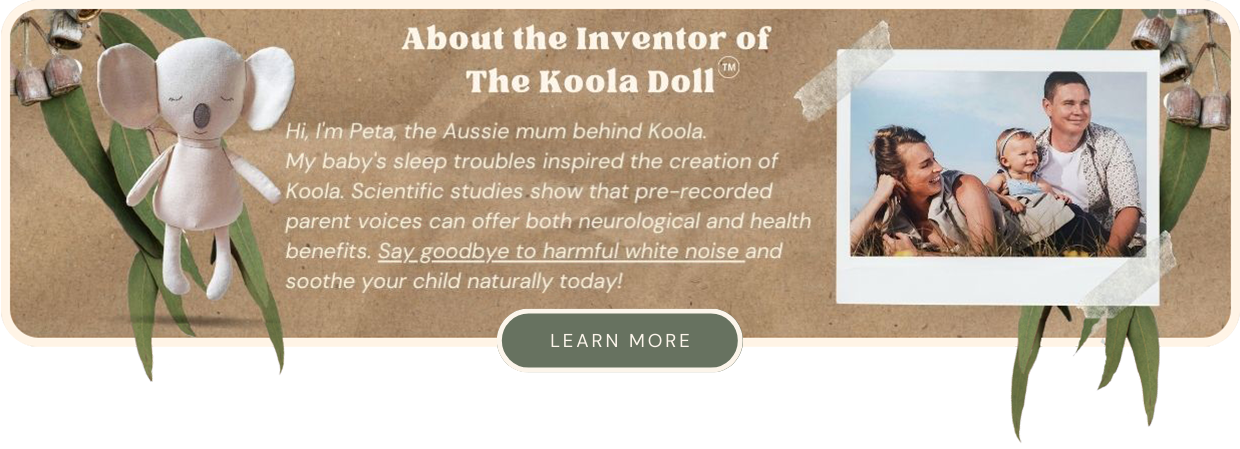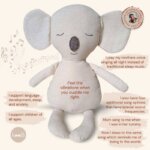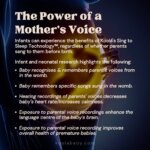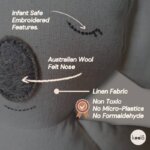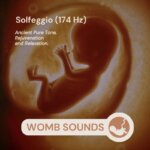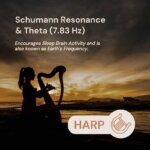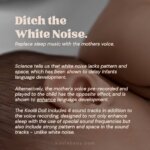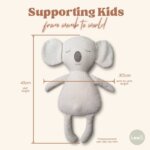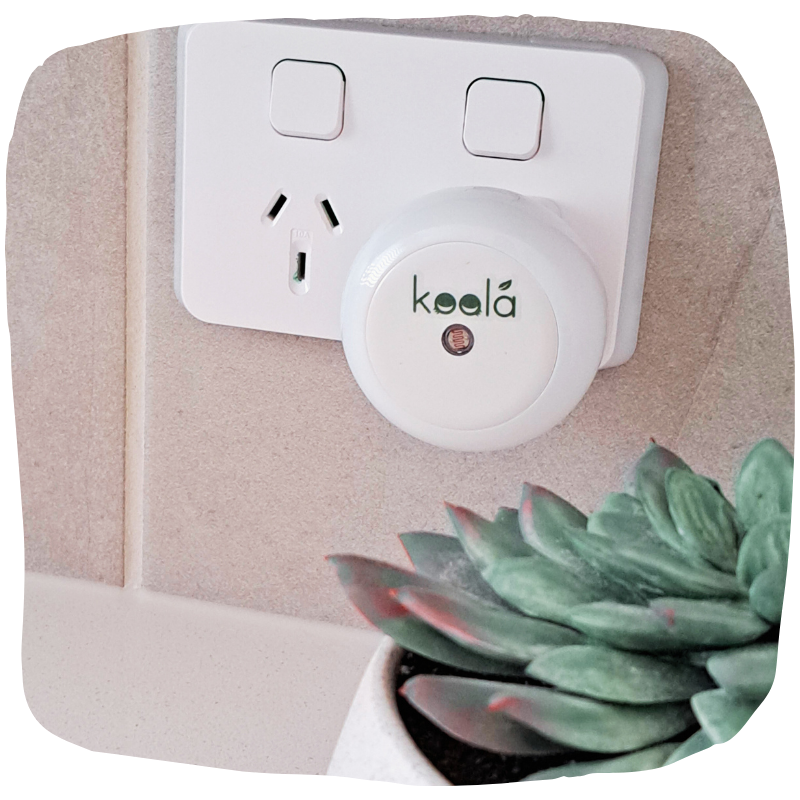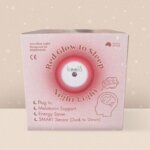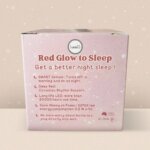The Koolá™ Doll as you may already know, was born out of a mother’s struggle to help her unwell child fall asleep. After trying many things, she discovered that singing her baby to sleep was by far the most effective intervention she had come across. This led her to delve deeper into the science behind this centuries old tradition. Her research yielded an abundance of positive findings, not only regarding the health benefits for infants but also the scientific evidence that explained why and how this method was so effective. The body of research she uncovered was overwhelming, and further solidified the importance of singing to babies as a powerful tool for promoting their well-being.
Pregnant? Now is the Time - Get Singing!
Today, you’ll discover an array of scientific evidence that shows how babies in the womb can identify their mother’s voice tone and other sounds they frequently hear, including sung songs and melodies. These memories support a sense of security and comfort for the child when re-experienced after birth. As a mother or pregnant woman you have the opportunity to utilise this information by applying the techniques mentioned.
If you are learning this after you have given birth to your child, do not worry; your baby likely associates your voice with the time spent in the womb and the mentioned methods should benefit your child whether it be for sleep support, anxiety, language development or one of the other many benefits.
Pregnant mothers however, have a unique and very special opportunity to support their unborn baby’s development even further nurturing prenatal attachment. Pregnant mothers can sing a chosen song repeatedly to their baby bump anywhere starting from the 24th week of pregnancy onwards. This will support the baby to recognise the mother’s voice, and also support the baby’s memory of the song after birth. This can further enhance the baby’s sense of calmness and security after birth when they hear you singing to them.

Today, you will explore a range of studies that demonstrate how playing recordings of the parent’s voice can help calm the child’s heart rate, as well as support language development amongst other health benefits.
Before we dig into the science, let’s hear from Penny Simkin, a renowned childbirth educator and author who is a huge advocate for prenatal attachment and passionate about singing to infants before and after birth. Penny describes to Lamaze International back in 2017, the powerful impact of singing to a baby during pregnancy and after birth, and recollects her early experiences with the method.
“As a birth doula, I have witnessed the power of singing to unborn babies. However, it was one couple who took my suggestion to another level and showed me much more about the value of singing to the unborn baby. They were having their second child, hoping for a VBAC. When they discovered that they were having a boy, they decided to give their baby the song ‘Here Comes the Sun’ and sang it to him often during pregnancy.
During the birth, the VBAC was not possible, and the baby was delivered via cesarean section. As the baby boy was raised for the parents to see, the father began belting out the baby’s song. Though the mother didn’t have a strong voice under the circumstances, she also sang. The baby turned his head, turned his face right toward his father and calmed down while his father sang. Time stopped, and tears appeared on the surgical masks of those present.
This event taught me the value not only of singing prenatally but also of singing the same song every day. The baby not only hears his or her parents’ voices, but also gets to know one song very well, and familiarity adds another feature to this concept. Fetuses have memory and prefer the familiar, which can be a source of comfort during their transition to extrauterine life.
As the baby was removed from the warmth, wetness, and dimness of the womb with its mother’s reassuring heartbeat, into the cold, bright, and noisy operating room, the familiar song helped him calm down and seek the source of the song. This gift from his parents moved everyone present, including myself, and left a lasting impression on me as a birth doula.” (Simkin, 2017)
Let’s Look at the Science that Supports Koolá’s Sing to Sleep Technology™.
Hearing Begins in the Womb.
Exposure to maternal sounds may play a critical role in preparing a newborn brain for hearing and language development. It’s believed that unborn babies first begin to hear around 20-24 weeks into gestation when neurons start forming connections in the auditory cortex. From inside the womb, fetuses are exposed to low-frequency sounds like their mother’s heartbeat and a muffled version of her voice.
Remembering in the Womb: The Impact of Prenatal Songs and Voices on Fetal Memory.
It appears babies are born with an innate ability to recognise the sound of their mother’s voice.This recognition is not just limited to the mother’s voice post-birth, but rather starts while the baby is still in the womb. It is shown that infants can recall more than their parents’ voices from the womb, they have memory of songs, music and stories that were consistently exposed in the last term of development in the womb.

In 1986, De Casper conducted a study that investigated fetal memory. In the study, pregnant women were asked to read a children’s story aloud twice a day during the last six weeks of their pregnancy. After birth, the newborns were presented with the same story, as well as a different story, and their sucking rates were measured as an indicator of their interest in the story.
The study suggests that newborns are capable of retaining memories from their time in the womb.
Another study on the topic by White, R. E., & Blumenthal, T. (1985) found that infants who were exposed to specific sounds in utero were better able to recognise those sounds after birth, suggesting that prenatal sound stimulation can affect auditory recognition memory in newborns.
A science review by Hepper (1991) on fetal learning before and after birth, focuses on the fetus’s ability to recognise and respond to external stimuli such as sounds, tastes, and smells. Hepper highlights evidence that fetuses can recognise and respond to sounds such as their mother’s voice, music, and other environmental noises. Evidence also suggests fetuses can learn to associate certain tastes and smells with specific foods consumed by the mother, which may influence their later food preferences.
Furthermore, the review highlighted the potential importance of prenatal learning for later development and behavior, such as the formation of social bonds and language development.
Another study conducted by Kisilevsky and colleagues (2003) found that fetuses exposed to a recording of their mother’s voice in the last trimester of pregnancy demonstrated increased activity in their nervous system, suggesting that they are actively processing and responding to the sound.
A large body of evidence shows that fetuses exposed to the sound of their parents’ voices, as well as memories of repeated stories and songs, can be retained. This informs us that while in the womb there is the opportunity for supporting a child pre birth with conscious exposure to voice and repetitive rhythm. The evidence strongly suggests that singing a song repeatedly to a baby while in the womb is not only beneficial for their development in utero, but would provide positive outcomes for the infant after birth.
Numerous studies have shown that babies can recall a range of experiences from the womb, most notably the parents’ voices and repeated songs. This highlights the potential for prenatal support through intentional sound exposure and rhythmic repetition.
The Role of Maternal Voice in Infant Brain and Language Development: Evidence from Neuroscience Studies.
Singer et al. (2016) conducted a study which found that infants who were exposed to recordings of their mother’s voice during a nap demonstrated increased functional connectivity in brain regions associated with language and social processing, compared to infants in a control group who were exposed to a stranger’s voice or white noise. This study provides evidence that maternal voice exposure can have a positive impact on the development of neural pathways associated with language and social cognition.

Benasich et al. (2014) also found that active auditory exposure to speech sounds in the first year of life can enhance the precision of acoustic mapping in the auditory cortex. This suggests that early auditory experiences can shape the neural processing of speech sounds, providing further evidence for the importance of early exposure to maternal voice and speech sounds in infant language development.
Moreover, Whitehurst et al. (1988) found that infants exposed to recordings of their mother’s voice had significantly greater increases in language comprehension scores than infants in a control group who were exposed to a female stranger’s voice. This study highlights the important role of maternal voice in promoting language development during early infancy.
Taken together, these studies suggest that maternal voice exposure during early development can have a positive impact on the neural pathways associated with language and social cognition, and can contribute to improved language comprehension in infants.
Mother Voice Supports ICU Premature Babies.
Preemie babies, or babies born before 37 weeks of gestation, often face a host of challenges in their early lives. They are more likely to have health complications, experience developmental delays, and struggle with sleeping (Engle et al., 2007). However, research has found that exposure to a mother’s voice can be a powerful tool in promoting healthy development for preemie babies.

A study conducted by Loewy and colleagues (2013) found that preemie babies who were exposed to recorded lullabies sung by their mothers had improved sleep patterns, heart rate, and feeding behaviors compared to preemies who did not receive this type of intervention.
Studies have shown that preterm infants benefit greatly from hearing their parents’ voices. According to a study published in the Journal of Maternal-Fetal & Neonatal Medicine, preterm infants who were exposed to maternal voice recordings had significant reductions in their heart rate, suggesting decreased stress levels and increased relaxation (Filippa et al., 2013). The study also found that preterm infants who heard their mother’s voice had better feeding and weight gain outcomes than those who did not.
Similarly, a study published in the journal Pediatrics found that preterm infants who received auditory stimulation in the form of maternal voice recordings had better sleep-wake organization and were discharged earlier from the hospital than those who did not receive the stimulation (Standley et al., 2010).
This highlights the potential benefit of Koolá’s Sing to Sleep Technology™ for preemie babies, as it allows parents to record their voices and play it to their preterm infants, even when they are not able to be physically present. This can help to provide a sense of comfort and familiarity for the baby, and potentially lead to better health outcomes.
According to a study conducted by researchers at Harvard University (Lahav et al., 2015) premature babies in incubators exposed to their mother’s voice and heartbeat experienced improved brain development. The sounds that were played to the premature babies in the study aimed to imitate the sounds that babies encounter while still in the womb.
The study involved playing recordings of mothers’ heartbeats, singing, and reading to their premature babies in incubators. The researchers used a stethoscope and microphone to record the sound of the mothers’ heartbeats from 40 premature babies. The researchers also recorded the mothers reading “Goodnight Moon” and singing “Twinkle, Twinkle Little Star” and adjusted the recordings by removing some of the higher frequencies.
Then, for three hours a day in 45-minute sessions, they played the recordings to half of the premature infants in incubators. After 30 days, using ultrasound scans, the researchers found that the infants who had been exposed to the recordings had thicker auditory cortices compared to those who had not. The auditory cortex is an area of the brain that plays a critical role in hearing and language processing.
The researchers speculated that applying this technique to other prematurely born babies may simulate the womb’s natural brain development.
Dr Lahav stated in Science magazine: “We have demonstrated that the auditory cortex is more adaptive to womb-like maternal sounds than to environmental noise”. He went on to suggest that the results are supported by the biological fact that maternal sounds would otherwise be present in utero had the baby not been born prematurely.

Lahav suggests that exposing preterm babies to just three hours a day of womb-like sounds may be enough to set the brain on the right development track. “Although the enhanced growth doesn’t prove anything about how the infants will do later on, we know from other studies that bigger is better when it comes to brain development in this region”, Lahav says.
Another study worth noting is a randomized controlled trial by Zare and Shahaeian (2017) which investigated the effect of music therapy on preterm infants in the neonatal intensive care unit (NICU). The study included 80 preterm infants who were randomly assigned to one of four groups: (1) music therapy with the mother’s voice, (2) music therapy with a lullaby, (3) standard care, and (4) noise exposure.
The study found that infants who received music therapy with the mother’s voice had significantly lower heart rates and respiratory rates than those who received standard care or noise exposure. The study suggests that music therapy with the mother’s voice can be an effective intervention for preterm infants in the NICU.
While there is ample scientific evidence to support the use of maternal sounds, particularly the mother’s voice, to improve health outcomes for premature infants, delving into every study would make this discussion overly extensive.
The Mother’s Voice - Speak or Sing - What is More Soothing?
Every child is different but reflecting on the research it appears that infants may be more responsive to and benefit more from sung melodies, than from speech alone.
Sandra E. Trehub, a music psychologist, conducted research on the effects of music on infants and found that babies remain calm for twice as long when they hear sung music compared to speech. This research was published in the Journal of Music Therapy in 2001.

In the study, infants aged 6-8 months were exposed to either speech or singing, and their physiological responses were measured. The results showed that infants had lower heart rates and less distress when they listened to singing compared to speech.
A study by Trainor and colleagues (2012) found that infants as young as six months old showed greater interest and attention to sung lullabies than spoken lullabies.
Another study by Standley and colleagues (2012) found that preterm infants who received music therapy with vocal melodies had greater weight gain and shorter hospital stays compared to infants who received music therapy without vocals.
Are Babies More Responsive to Mum or Dad’s Voice?
Researchers have consistently found babies in the womb respond to both parent voices.
The study titled “Fetuses Respond to Father’s Voice But Prefer Mother’s Voice after Birth” was conducted by Christine Moon and colleagues and published in the journal Infant Behavior and Development in 2013. The aim of the study was to investigate whether fetuses are able to distinguish between their mother’s and father’s voices and if they show any preference for either voice.
The study involved 12 pregnant women who were between 7-8 months pregnant and their partners. The couples were instructed to speak or sing in a specific order so that the researchers could record the fetal response to the sound of each voice. The researchers used a non-invasive fetal magnetocardiogram to record the fetal heart rate in response to each voice.

The results of the study showed that fetuses were able to distinguish between their mother’s and father’s voices and responded with an increase in heart rate to both voices. However, after birth, infants showed a preference for their mother’s voice compared to their father’s voice. The study suggests that fetuses are capable of learning and responding to voices before birth, but postnatal experiences may shape their preferences for specific voices.
Kisilevsky et al., 2003, also examined whether fetuses could recognise and differentiate between the voices of their mothers and fathers. Pregnant women were asked to read a passage out loud twice a day for six weeks, and then their fetuses’ heart rates were monitored while they listened to recordings of their mothers and fathers reading the passage. The results showed that fetuses were able to recognise their fathers’ voices but did not show a preference for the father’s voice over their mothers’ voices.
Numerous studies have explored infants’ preferences for various sounds and voices, including non-vocal music and other women’s voices, but consistently, the mother’s voice has been found to be the preferred sound. For instance, Bergeson and Trehub’s (2002) study revealed that infants favored their mother’s singing voice over a female stranger’s voice, indicating that familiarity with the mother’s voice strengthens auditory perception and preference.
While the father’s voice may not be the number one preference for most infants, it is important to note that every child is unique and some may prefer their father’s voice. It is also worth noting that infants remain highly responsive to the father’s voice, so utilising it in a soothing product like The Koolá™ Doll can be highly effective
The Koolá’s Sing to Sleep Technology™
The Koolá™ Doll was inspired by a centuries-old tradition of parents singing to their babies. From ancient lullabies to modern children’s songs, singing has been a universal way to relax and soothe babies throughout history. But as you have learnt today there’s more to this than just tradition. The Koolá™ Doll bridges this historical custom with modern yet safe EMF free technology, providing a tool for parents to enhance their baby’s well-being and create a special bond through the simple act of singing.
Following the Koolá’s Sing to Sleep Method:
- WHAT SONG: Choose a song that is easy to sing – for example the song: You Are My Sunshine. If you cannot think of a song you love enough you can make a song up, or use a nursery rhyme. Keep it simple, and repetitive.
- SING, SING, SING: Sing to the baby bump several times per day, especially when the baby is awake and kicking etc.
- FAMILY BOND: Promote other family members to sing your song to your baby bump.
- SENSES: Touch your stomach when singing where possible.
- VOLUME: Sing and speak loud enough but do not allow anyone to scream in close proximity to your bump as your baby’s ears are very delicate. Also be wary that any loud noises would not benefit your baby in the perinatal stages.
- SOUND TRACKS: Also play the 4 songs from the Koolá music box to your baby bump as it will help to create a positive association with those songs in preparation for their use after birth.
- AFTER BIRTH: Record your special song into the music box (Following the detailed instructions in your instructions booklet and order email) *If you did not sing a song pre birth, do not worry – your baby is familiar with your voice so choose a song now and record it. *Pro tip: Sing your chosen song for no less than 30 seconds before locking it into the music box. Also do not allow for any silence before you click record OR at the end of your recording. This will ensure the song sounds seamless when played back.
- IMPLEMENTATION: Devise a plan for your child for when you will play the voice recording as well as the other sleep sound tracks. Will you play the song all night? Will you play the song for the first hour? Consistency is key in creating the associations you are wanting to achieve. And readjusting where needed when you notice what the child responds to best.
What Strategy Works Best?
You may choose to play your sing to sleep song randomly to sooth your baby whenever you feel the need. Or you may make a plan to keep your personalised song for sleep only and create a strong sleep association with that song. You also may decide to use the 4 Koolá soundtracks to be a part of your child’s pre-sleep routine or even use them during sleep. There is no right or wrong way to use the Koolá Doll as it is designed for all round goodness.
An example is to play one of the Koolá soundtracks before their bath, another track during their bath, another track before book time or during cuddle or feeding time. And leaving one track for car trips etc. As the parent you will know the best application and you may also experiment and see what works and adjust your plan. Babies feel calm when they know what is going on. Visual prompts inform them of what is happening and if routines are consistent they learn what comes after one activity. Object permanence is an important concept to understand so as a parent you can reach successful sleep outcomes. Read here about object permanence, sleep associations and sleep cycles. Just know that consistency is key. Before you start, make sure you have a think about your strategy. It takes time and persistence to develop routines that work, so stick with it.
Another decision you need to make is about the length of time you want the sound box to play. Do you want your child to sleep all night with the sound playing so when they wake it maintains that consistent sleep environment? If so, select the 8 hours play time. Or do you want to play the sound just until they are in a deep sleep? If so, select the 1 hour play time.
Challenges You May Face.
Older Child.
Your situation may be different to what has been previously discussed. You may be introducing the Koolá Doll when your child is older and they have already established a routine and sleep associations around white noise. In this case you should still try your personalised song as there are potential language benefits compared to white noise. White noise is shown to hinder language development so swapping over to our other tracks or your voice track is in their best interest. If your child is not responding to your voice you may find using one of the Koolá soundtracks better for the transition as white noise is very different to vocals and your child may find the change too contrasting in a short time period. After several nights (more than 4), gradually transition from a Koolá soundtrack to your personalised song. The Koolá soundtracks include science backed sound waves that soothe and relax so if you decide to use these sound tracks for sleep it is also a huge win.
Technical Struggles:
It is recommended that before you record your song into the sound box – to watch the instructions video and follow the exact steps. You can find the instructions in your order emails. We also have them written in the Dolls instructions booklet inside the packaging. If you have watched the video and followed the written steps and are still not able to record your song successfully, reach out to us here.
References
DeCasper, A. J., & Fifer, W. P. (1980). Of human bonding: newborns prefer their mothers’ voices. Science, 208(4448), 1174-1176.
Engle, W. A., Tomashek, K. M., & Wallman, C. (2007). “Late-preterm” infants: a population at risk. Pediatrics, 120(6), 1390-1401.
Feldman, R., Weller, A., Zagoory-Sharon, O., & Levine, A. (2010). Evidence for a neuroendocrinological foundation of human affiliation: plasma oxytocin levels across pregnancy and the postpartum period predict mother-infant bonding. Psychological Science, 21(3), 286-291.
Filippa, M., Devouche, E., Arioni, C., Imberty, M., & Gratier, M. (2013). Live maternal speech and singing have beneficial effects on hospitalized preterm infants. Acta Paediatrica, 102(10), 1017-1020.
Huttenlocher, J., Haight, W., Bryk, A., Seltzer, M., & Lyons, T. (1991). Early vocabulary growth: relation to language input and gender. Developmental Psychology, 27(2), 236-248.
Kisilevsky, B. S., Hains, S. M., Lee, K., Xie, X., Huang, H., Ye, H. H., … & Wang, Z. (2003). Effects of experience on fetal voice recognition. Psychological Science, 14(3), 220-224.
Lahav, A., et al. (2015). Music facilitates the development of syntax in children with developmental delays. Frontiers in Neuroscience, 9, 1-7.
Loewy, J., Stewart, K., Dassler, A. M., Telsey, A., & Homel, P. (2013). The effects of music therapy on vital signs, feeding, and sleep in premature infants. Pediatrics, 131(5), 902-918.
Mills-Koonce, W. R., Propper, C., Gariepy, J. L., Barnett, M., Moore, G. A., Calkins, S. D., & Cox, M. J. (2015). Infant and parent factors associated with early maternal sensitivity: a caregiver-attachment systems approach. Infant Behavior and Development, 38, 20-30.
Nazzi, T., Bertoncini, J., & Mehler, J. (2000). Language discrimination by newborns: toward an understanding of the role of rhythm. Journal of Experimental Psychology: Human Perception and Performance, 26(3), 756-764.
Simkin P. (2012) Singing to the baby before and after birth. International Doula 19(3):30-31.
Simkin P. (2013) ‘There’s a Baby: A Children’s Film About New Babies’. Passion Flowers Productions: Seattle.
Standley, J. M., Cassidy, J., Grant, R., Cevasco, A., & Szuch, C. (2010). The effect of music reinforcement for nonnutritive sucking on nipple feeding of premature infants. Journal of Pediatrics, 117(4), e630-e636.
Trehub, S. E. (2001). Musical predispositions in infancy. Annals of the New York Academy of Sciences, 930(1), 1-16.
Bergeson, T. R., & Trehub, S. E. (2002). Absolute pitch and tempo in mothers’ songs to infants. Psychological Science, 13(2), 72-75. doi: 10.1111/1467-9280.00413.
Zare, Z., & Shahaeian, A. (2017). The effects of music therapy on physiological responses of preterm infants in neonatal intensive care unit. Journal of caring sciences, 6(3), 247–253.
Zimmerman, E., Lahav, A., & Otterbein, L. (2011). Acoustic features and acoustic packaging of maternal speech to preterm infants. Journal of Pediatric Psychology, 36(2), 143-153.
Disclaimer: The information provided in this article is for educational purposes only and should not be considered as medical advice. Always consult with a healthcare professional before making any changes to your health routine or treatment.




